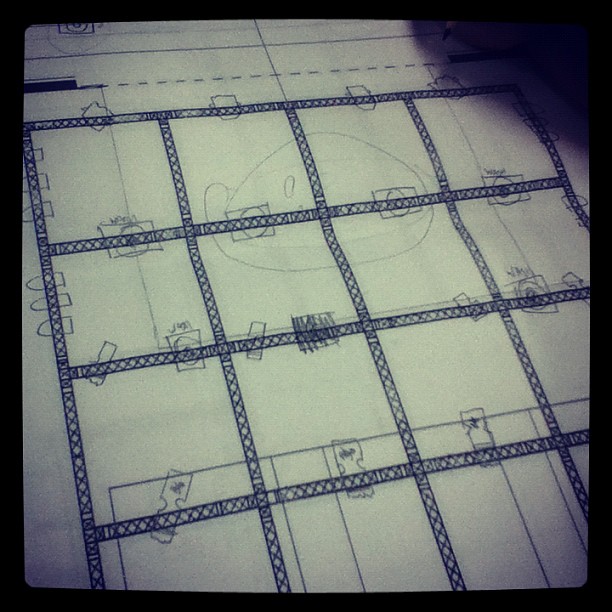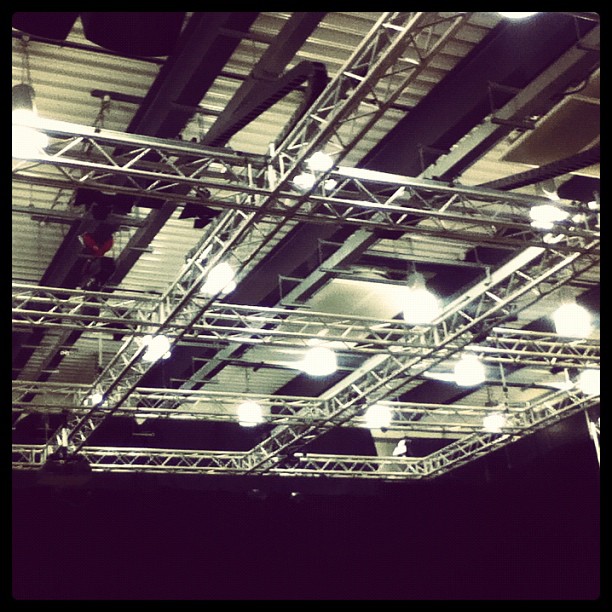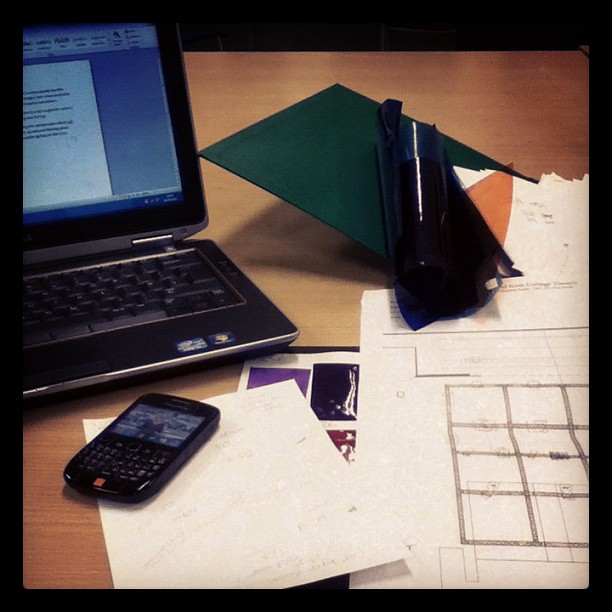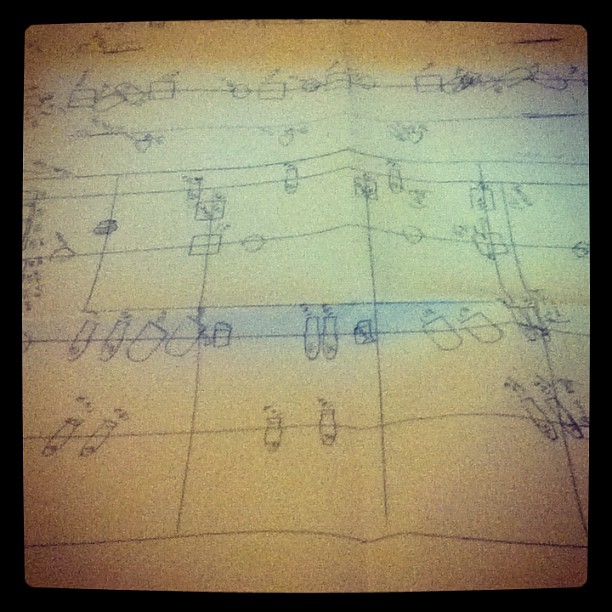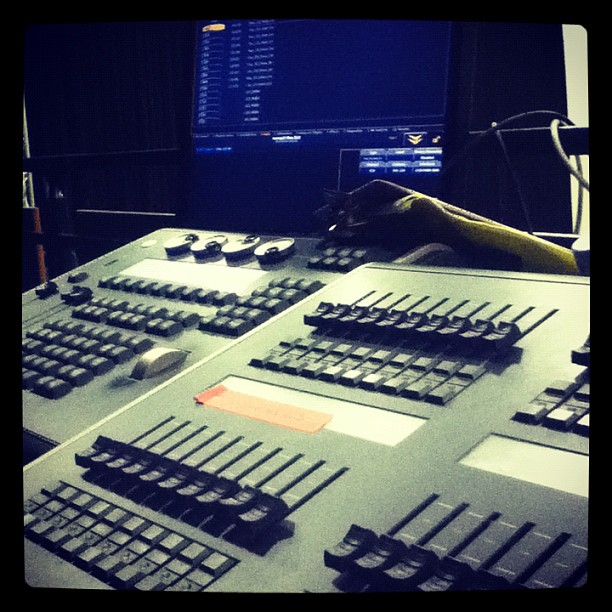Photos from the Theater! Aka Behind the Scenes!
So, Ive been working as Head Lighting Designer for the Cinderella show coming up! So along the way I’ve taken some photos! I will get some more photos of the actual production process but here is some of the Lighting aspects of it!
 Stripping down LX bars ready to rig! Yes its messy! We soon tidied up!
Stripping down LX bars ready to rig! Yes its messy! We soon tidied up!
 Rigging up some floorcans onto scaffolding bars as part of my Lighting Plan! These will go on the stage LX bars giving extra color into the stage!
Rigging up some floorcans onto scaffolding bars as part of my Lighting Plan! These will go on the stage LX bars giving extra color into the stage!
 One of our moving head fixtures! Mac 250 entour! Can sit around with these for hours!
One of our moving head fixtures! Mac 250 entour! Can sit around with these for hours!
 My view this evening from the lighting desk (ION)
My view this evening from the lighting desk (ION)
I spent most of my evening soft patching! This involved patching the lights into channels which would make it easier to programme, knowing where each fixture would be. I also had to address DMX to the Mac 250 entours and Mac washes, and to the LED RGB Battons Ill be using within my lighting design!
Overall, not many photos, but gives you an idea of whats been happening!
xoxoxo
New Project!
So I also stated when I started this blog, that I would also keep everyone up to date in my upcoming projects and progress as I make my way through the technical world.
My new project as head lighting designer has fallen into place, as I take on the work of being Head LD for Cinderella. So, I’ve already began working on this project and I’m a little late in making this blog entry, but its all good 😉
First of all my start to being designer for this show hasnt gone exactly smooth, seeing as though the director has YET to give me a script! Never good! But on the other side to it, as head LD, I can’t sit around doing nothing until I get a script, so its been all about planning, advance planning, and even more planning. And I’ve taken some photos for you guys along the way 😉 see im nice really.
I started off my planning by checking what lights we have available, and also what space Id have, I have had to work along side the set designer and the director in order to know where I have space! Because of cloths, and gauze flying in from LX bars, some of my space has been limited down. At present I have the full truss, and only 2 onstage LX bars.
After finding out exactly just how many lights I was able to use within my design, it was time to look at lighting gels! They’re known as color gels, color filters, lighting gels or simply, gels. But whatever you call them, color gels are thin sheets of polycarbonate or polyester that project color when placed in front of lighting fixtures. Such as the parcan.
 Above is the pack of LEE FILTERS I often use when picking out color gels. This pack of Lee Filters helps a lighting designer look through colors and find numbers of colors they need, the numbers used help with a lighting plan, giving riggers the correct number in order to rig the lights properly with the correct gels, but also helps the designer order the required gel colors. I spent a while looking through and chose some colors to use.
Above is the pack of LEE FILTERS I often use when picking out color gels. This pack of Lee Filters helps a lighting designer look through colors and find numbers of colors they need, the numbers used help with a lighting plan, giving riggers the correct number in order to rig the lights properly with the correct gels, but also helps the designer order the required gel colors. I spent a while looking through and chose some colors to use.
In the end I have ended up using 117, 137, 132, 106, 135, 119, 128, 202, 103, 136, 126. For a non-lighting designer or non technical person, those numbers would mean nothing!
I then constructed a small non-scaled plan of the trussing for the space the show will be held.
I then began jotting down some ideas on lighting positions, It was hard to do this without actually going into the theater, but I was able to give myself a rough plan of what I think could work before heading into the theater to give myself more creative options.
I then went into the theater to have a look at what space I would have, and to get a more creative feel of where and what area of staging I would need to cover, and the actual space I have. This is the theater I will be working in, and where the show of Cinderella will be performed!
As of now most days have consisted of sitting in front of paperwork, constructing ideas, lighting plans, patching plans and developing research, looking at previous shows of Cinderella and thinking of the best ways to light the actors and actresses, whilst also making sure I light the set without flooding the stage too much. Cinderella is a colorful show, needing as much color wash, and specials as possible, which is why I mainly opted for Mac 250 washes, Mac 350 entours, and the trusty parc 64s! My rig also consists of LED Fixtures, LED Battons, Fresnels, 500W floods and a range of Source 4s with various degrees.
As of now, my current lighting plan consists of this:
Not a great photo! 😉 But you get the idea. My lighting plan can change at any minute, either adding or taking away fixtures in order to make the show work best. I’m currently in total using approx 66 generics, 6 LED’s, 6 Macs (washes/entours) and 4 LED Battons. Ill be working with the ION ETC Lighting Desk. Not the most amazing desk, but its easy to use compared to many. Picture of the desk:
As of tommorow, I will be constructing my final mood board for the show, Ill be within the theater, and making my lighting plan on a TO SCALE drawing, Ill also be watching rehearsals of Cinderella and making notes on when cues could come in, ready to help my Lighting assistant programe the show. I will also be over seeing rigging also rigging myself, over seeing focusing of my lighting, and making sure all lighting areas are covered and sorted.
I will make another post tommorow with more photos!
The Lighting Designer
When we go to concerts most of us don’t tend to look at the lighting, unless your into technical. Most people spend their time looking at the band. But how much work is actually put in, to make your show look good, and to light your band members so you can enjoy the show. Stage lighting for live music is essential, not only to actually see the bands/musicians on stage, but also to enhance the music and create an atmosphere for the concert. Lighting is meant to help out the band, but not be the star of the show.
But lighting happens in more places than you would think of, lighting designers create the lighting not only for music but for theater, dance, opera, television shows, video/film and movie productions. They can also be involved in lighting museum exhibits, public parks, and large buildings, dances, religious occasions, public events, fashion shows, and festivals. Wherever lighting needs to be dramatic and highlight a person/band/ group or monument, lighting designers have a hand within the task at hand.
Lighting designers are responsible for setting the mood for each scene, song, environment or set. And the process to do this is more than just pressing a few buttons and making lights work. Its a far bigger and longer process.
Lighting designers often work as technicians as well which requires them to help setting up and running the lights. This requires a good technical knowledge of how to rig, patch, and correctly fix the lights to the trussing with safety clamps. Lighting designers and Lighting Techs have to have a comfort with heights, and a good sense of timing when programming for a song.
Typical responsibilities of a lighting designer:
- If the show is for a theater project, the first thing the designer needs to do is read the script. But for this blog. I’m talking about music. So in the case of the music, the designer may listen to the band’s music in order to gain a feel of the music.
- Discussing the technical requirements.
- Researching the venue- This is very important, as a designer needs to know the technical specs of a venue before designing a lighting plan. Knowing the space, and trussing available will give the design an idea of what equipment would be suitable, and what lighting they are able to use. Some venues already have their own equipment so it’s good to find out what they have, and see if you are able to use that.
- Establish a lighting plan, drawing it out for the technicians- Another important step. Drawing out the lighting plan so that all your lighting crew are able to help you rig. Drawing out a lighting plan takes careful thought, and thinking about many lights which would be able to light the musician/band in the best way possible.
- Whilst deciding and designing the lighting plan the lighting designer must think of the lights, gels and any other additional equipment that may be required.
- Once the lighting plan is ready, the designer along with the crew will travel to the venue, this could be straight after another show, taking all the equipment down, travelling hundreds of miles and reaching the next venue after as much sleep as possible getting the equipment into the venue, the lighting designer will then supervise the hanging and focusing of lighting instruments, ensuring that the lighting plan is being followed, and the lights are in the correct position, facing the right way, and working.
- Whilst travelling the designer would have already plotted the songs before touring, or spent hours of time pre-programming the lighting with the correct plan on lighting software. Or the designer will spend time with the lighting desk programming songs, ready to connect with the lights up in the stadium. A typical song could take from 4-9 hours to program depending on the requirements. So imagine how many songs are programmed for Bon Jovi, and how much time the designer had spent in order to have the lighting ready for the show.
- May maintain and repair the equipment- A lighting designer should have knowledge in fixing and maintaining the equipment. Having the knowledge to know how to fix the lights come in very very handy!
- Ensuring the show runs smoothly.
- Create a production notebook containing: Contact information if any lights have been hired, contact information for the crew, and for organisations who the equipment has been bought from. Schedules for lighting meetings, load ins, get outs, rehearsals, sound checks. Notes from meetings, the band may have certain lighting requirements they want. Research of the venue and any other relevant research. Sketches, lighting sketches, lighting plans, ideas. All lighting documentation.
- Be in communication with all members of the production team about any issues that might affect others such as color, if the musician is wearing something specific, it needs the correct lighting. Texture, Floor surfaces, fog, smoke machines, safety issues, special effects, things on stage. To keep in contact with all of the team, so team work and communication is vital.
- The Lighting Designer needs to provide the Master Electrician with atleast 3 copies of the lighting plot, access to the paperwork, and any other required details.
- The Lighting Designer will be in very close contact with the Director (For a theater show) Stage Manager both for music events and theater shows, Production Manager, Master Electrician, Technical Director, Set Designer, Costume Designer and Sound Designer for any changes that might affect the lighting, again communication is a must!
Below is the lighting desk used for Bon Jovi shows. The GrandMA lighting desk.
The typical average cost of the GrandMA lighting desk in FullSize will range. But retail at $78,500. For a smaller size, retailing at $57,000. These are prices without of course the other things that are required to go with it.
Next time you attend a show, take a second to look at the lighting, and think of the process the designer and the team have gone through in order to make that happen. And remember, without the lighting designer, you wouldn’t be able to see your band 😉
Income and Expenses of Touring!
When we look at music artists these days, we assume that every single ticket we buy, goes straight into their pocket.
Wrong.
The list of typical expenses to your music artist are more than you think, and the amount of work that has to be put behind all of the shows you attend is amazing. And something a lot of people never think about.
So below is a small list of each, both income, and expenses of touring. You will be surprised by which list is the longest!
INCOME
- Live Performance Fees- Some TV shows may pay the band in order to have them appear on the show to increase ratings.
- Record Label Recording Contract Royalties- The band get paid a percentage of each album sold.
- Publishing Income Sources- The primary sources of income of a song include performance rights, mechanical licenses, synchronization licenses and print rights. These sources can be exploited through film, television, videos, records, CDs, tapes, MP3 downloads, sheet music, commercials, broadcasting, internet distributions, as well as other forms of exploitation. For example, when a Bon Jovi song was used on Glee. They would of needed to get rights to use that song.
- Mechanical Royalties (Sales of CDs, DVDs)
- Performance Royalties (Such as Broadcasting, Radio, TV, Satellite radio)
- Synchronization Fees (TV, Film)
- Sheet Music Sales- If any of you have books from a band with various sheet music to help you learn an instrument.
- Commercial Jingles- Some companies wish to use a song within their commercials. This way the band will get something back from the company using their song, whilst the song gets more publicity, and helps the company to promote their item/service.
- Merchandising Royalties- All the merchandise we buy, t-shirts, key ring’s, hoodies, photos, various merchandise, again only a percentage of this goes directly to the band, the rest will go to other companies.
- Internet streaming/ downloads- Single’s coming out, album downloads, single downloads. This is why when you don’t buy the artist’s music and rip it from you-tube, it does hurt your favorite artist. You haven’t downloaded the song from them. You have stolen the song.
- Book/ DVD Sales- When a band releases a DVD of their tour or book (Such as When we Were Beautiful) again a percentage will go to the band, the rest to the crew/publishers who helped in order to create it.
EXPENSES
- Equipment Rental charges- In-case the band require certain lighting within a stadium or a certain instrument for a song, the extra pieces may be hired in either that or paid for fully.
- Guest Musician fees- Have you been to a show where a special guest has appeared onstage? Usually they will want something for doing it. Unless they are very good friends with the artist, then they may just do it out of pure musical love 😉
- Recording within a studio, costs will be on: Producer, Engineer, Studio Hire, Audio Supplies, Mastering Fees, Graphics artist, Photographer, Cover Art Costs, CD/Vinyl Manufacturing and duplication Charges, along with Marketing, Sales plans.
- Publicists Fees
- Promotion for the tour- Flyers/Billboards/Posters/TV Commercials/Radio Ads
- Photographer fees and duplication charges- At one stage a few of us have had a look into having a photographer for an event, and we all know some of the charges!
- Internet Website costs (Design, maintenance, access fees etc. Your artist will need to pay someone to run the website, keep the designs up to date, keep the information up to date. This all costs)
- Misc. online promotions- Free MP3’s, Free downloading. Something artist’s can do to get their music out there.
- Band Equipment Costs- For example, Richie Sambora requires several pedals, talk box effect.
- Instrument purchases/rentals – New guitars/ Drums/ Bass/ Vocals
- Tour Luggage- Transporting equipment to each venue, each country, each city.
- Misc. equipment repair/maintenance costs (drumsticks, strings, tuners etc)
- Tour Equipment- Lighting Desks, Sound Desks, FOH, Stage Monitors, IEM In Ear Monitors, Mics, Drum mics, keyboard mics, acoustic mics.
- Rehearsal space costs- Using the arena/stadium days earlier in order to practice, halls and studios to practise.
- Office Expenses- Taxes
- Songwriting – Copyrighted songs registration/ filing costs if a band was to use other artists songs live. Or re-record the song in their own way, they would need to do this.
- Performance Rights Organization Fees ( ASCAP-BMI-SESAC)
- Conferences between tour team- budget
- Artist Business Team Costs such as a Personal Manager, accountant, booking agents, publicist, music attorney
- Transportation costs- Trucks to carry the equipment, getting them on ships. Planes, air fair. Highway and ferry tolls. Gas expenses, service and repairs to the trucks. Cars to take the band to and from venues, and interviews.
- Merchandise (T-Shirts, Hoodies, Bags, etc) Expenses such as designing costs, manufacturing and shipping costs, how much it will cost them to send to us, to some countries items can be hefty in cost, so free shipping is a BIG advantage when they offer it!
- Costumes/Stage clothing- What the band wear on stage, someone will often be in charge of getting together a wardrobe which is comfortable for the band, you wouldn’t expect to see Jon Bon Jovi on stage during a tour wearing a suit, yet maybe at an event for the White House you will. But for an artist, they would rather be comfortable on stage in something they can move around in and give you a good show.
- Insurance- Needed on health, equipment, instruments, life cover. If any accidents or incidents where to occur. We all know this.
- Unions
- Video production and manufacturing costs of CD’s and DVD’s. Recording events. You will see camera’s at Bon Jovi show’s, Tony Bongiovi will be backstage, recording some, and making sure that you get a good view up on the screens! Equipment such as cameras and all of the equipment in order to make that work is also required.
- Road Manager/Band Manager/Accountant/Roadies salaries. All of us roadies need paying its a hard job!
To all of the above, there is probably many things I have even MISSED! But that is the average income and outgoings of a touring and musical artist. Some of the things as consumers, we never thought about.
Before going on to you tube and downloading your favorite artists new song or an artists song, remember. The amount they have spent making sure you get it and enjoy it as a fan! 😉
A promoter might take over some of the work on tour, to ensure the tickets, advertising and sales are covered. But remember, just as an EXAMPLE Say a band were to tour for 12 months, the promoter puts in $5 million into making sure everything was sorted. If over that 12 months, the total income was to be exactly $5 million. The band would receive nothing. Only the other incomes they have in place.
xoxoxox
New Blog!
So, I decided to begin a blog. Not about myself, not about bands, but about something I’m studying something I’m passionate about and something many music fan’s do not think about.
The work that goes on BEHIND the scenes to make your show even happen. Without the technical crew, behind the scenes, none of the concerts you have enjoyed would have gone ahead, and if they had, they wouldn’t of been great.
Over the years, I’ve been told my choice of career was “not realistic” and that I should get a real job. When in fact the people saying it, really had no idea what the job of a technician or backstage crew really entitles.
What do I get from this blog? Giving you guys knowledge of the hard work that really goes on behind the scenes at your favorite shows, and the technicians that get called lazy, or told to “get a real job” in fact do! 😉
I’ll be covering a lot of subjects, a lot of topics and various shows I’m working on as a technician myself, and maybe over the years, as I enter the industry, Ill cover more and more things as I go (:
Hope you enjoy the blog, and I hope it gives you more of a clue of the work that happens…..The tech…to the music (:
xoxoxo





